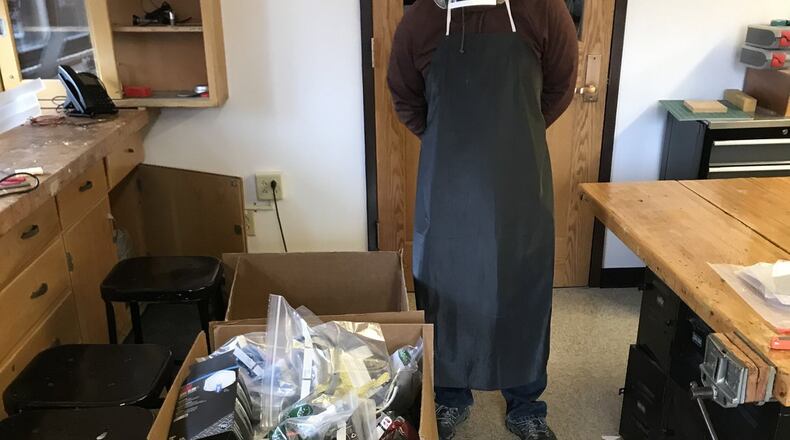CORONAVIRUS: Complete coverage from the Dayton Daily News
Grant Crane, 18, is a senior at Oakwood High School, and is happy to be a part of the project.
“Because of the recent pandemic and the lack of supplies to many hospitals in the area due to its sudden and devastating nature, the idea was drawn up to use members in the community who owned 3D printers to make the masks necessary for the hospital to keep up with its patients,” he said.
“Oakwood was contacted because it has a workshop with a few 3D printers in it. From there students who were known to have printers themselves were contacted to help with the demand and now there is tons of members all over the Dayton area helping to fight against the virus in what ways we can.”
Oakwood High School teacher Tony Rainsberger said there are many people involved in the project, and it is part of a larger effort put together by a group called the “Resilience Dayton Mutual Aid Coronavirus response” led by Sarah Moore, who is also disaster coordinator for the Shiloh Tornado Resource Center.
“She put together the group to try to address some of the supply needs of the medical community during the coronavirus outbreak,” Rainsberger told the Dayton Daily News. “She has a lot of different people working on those needs.”
He added that Moore reached out to Wenbi Lai, who is an engineer in the Oakwood community, and Lai reached out to people who had 3D computers to join in the mask-making effort.
“When she reached out to us, she said ‘we want to make some face shields,’” Rainsberger explained. “I contacted the principal and two other teachers who help with the engineering program at Oakwood and said, ‘Hey, can we do this?’”
The teachers were told that since school is closed down they would be welcome in the engineer shop, but would just have to limit the time they were in there and to practice social distancing.
Brian Hartt and Scott Zipperian are the other teachers involved. Along with Rainsberger they teach pre-engineering and science courses.
MORE: Honda forced to lay off full-time workers
“We said that we would love to be involved, but 3D printers are really slow so we knew one of the bottlenecks with this would be printing the face shields,” Rainsberger said
He said there’s three components to the face shield: “There is a headband that holds the shield on and sits up against the user’s forehead, and a clear plastic shield that attaches to that headband. And at the bottom of that plastic shield there is a part that keeps it curved.”
Knowing that it was going to take time to make the shields, the teacher reached out to a number of students who they knew had 3D printers to help with the effort.
The 3D printers are running nearly around-the-clock, as the headband and curve retainer pieces are part of the 3D process that is designed by a company called PRUSA.
On Wednesdays and Sundays, people that are printing the shields sanitize them and drop them off at the school. Rainsberger, while wearing gloves and a shield, removes them from their bags and instantly drops them into a bleach solution to avoid cross-contamination.
They are assembled, with the forehead piece attached to a bandana that users can wear, and then they are air dried. The finished product is put in a ziplock bag with a set of instructions that explain the assembly process.
“We assembled our first 101 shields on Sunday and delivered those on Wednesday.” Rainsberger said, adding that there has been a request for at least 1,000 of them, but the priority is to try to get them out to area hospitals.
MORE: What’s the result of toilet paper shortage? You guessed it, clogged pipes, say area plumbers
About the Author
